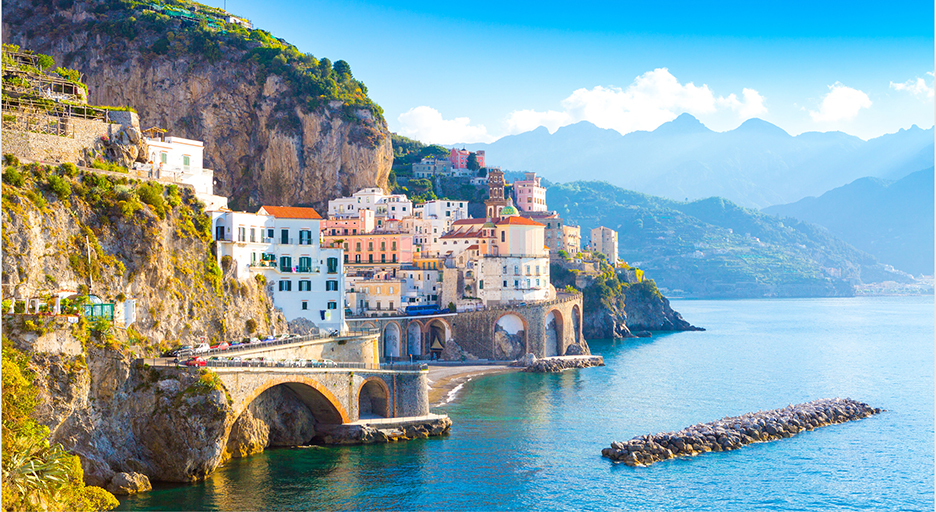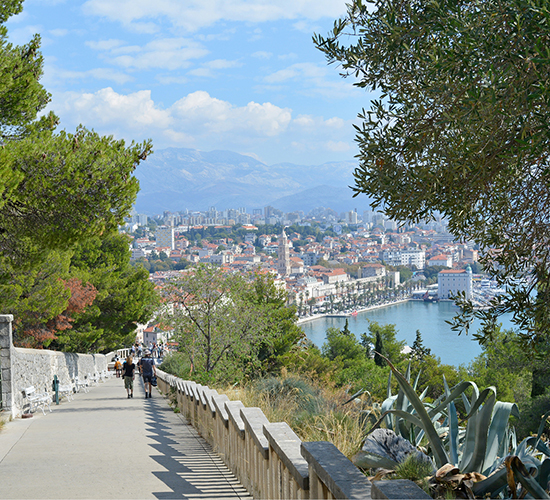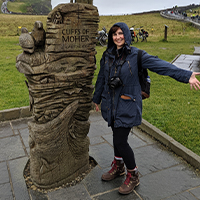
With inviting and diverse cultures, incredible natural scenery and azure waters, history going back to the dawn of civilization, not to mention the delicious local food and drink that make up a world-famous diet, the Mediterranean certainly has its share of draws. The only questions left: When, where, and how should you go? (Spoiler alert: There’s no wrong time to go, only best times to fit with your style and interests.)
When to Go to the Mediterranean
Many think of summer and the Mediterranean – for good reason. The region’s iconic destinations like the Greek islands, Croatian coast, and the Italian Riviera promise days filled with sunshine, ocean breezes, and cooling off in the sea. Summer is a prime time to visit – and many do, so keep in mind you’ll be among the many who flock to the coast
Fall brings more calm to the streets as locals return home to their routines, while the historic sites and landmarks still bustle. Winter and spring usher in a quieter atmosphere and cooler temperatures, which can make sightseeing that much more enjoyable and stays in European hotels (which typically don’t have A/C) that much more comfortable. While island hopping takes a backseat off-season, fascinating medieval cities and towns and historic landmarks invite you in to slow down and explore.
How to Go to the Mediterranean
There are always the big ships for that Mediterranean cruise sampling the region’s many incredible destinations – but in this author’s experience, it will leave you wanting. Wanting to linger longer than the big cruise lines can stay ashore… to wander the winding streets of old cities early or late in the day… to dine among locals for meals you’ll remember… to just settle in and let the places you’ve always wanted to know sink in.

Guided touring, however, offers balance with an expertly planned itinerary that blends essential sightseeing and unique local experiences, built-in time to explore destinations your way, and the invaluable benefit of having an expert guide at your service. You’ll also be alongside fellow travellers for a journey where so many unforgettable experiences are best shared. Whether by a land tour or small ship cruising, the guided touring experience is the way to spend your time going deeper in the Mediterranean.
Mediterranean Destinations by Season
Take these tips from Collette’s experts on the best times to travel to popular Mediterranean countries and what to expect by season.
Greece

Spring: Santorini, Mykonos, and other Greek islands open to tourists in mid- to late April. While the weather is mild, most find the beaches are still chilly for swimming or sunbathing. Minimal crowds yield maximum photo opportunities.
Summer: July and August in Greece are hot! (In extreme heat, it’s possible for the Acropolis to be closed during the hottest hours of the day to protect workers and visitors.) During the summer season, tours only run in early July and late August, when temperatures aren’t as extreme. It’s during these months when many Greeks and other Europeans vacation here, too.
Fall: With kids back to school, September and October are great times to visit. Greece remains very busy, as the tourist season on Santorini and Mykonos extends into October, and the water temperatures offer perfect swimming conditions. There may still be crowds at the Acropolis and other popular sites along the way.
Winter: Picturesque Arachova, a ski town, attracts travellers to its slopes during the winter (December through March). Yet even on the coldest days, temperatures rarely dip below freezing. During winter in Greece, take opportunities to explore inland and experience the local culture.
Reasons to visit Greece year round
Italy

Throughout Italy, the most popular times to visit are April, May, June, September, and October. Along the coast, July and August are busy with locals and Europeans on summer holiday, while cities are usually less crowded.
Winter: Go in December, January, and February for Venice, where you can take a walk beside the canals on a quiet evening and hear your footsteps echoing off the water. Catch the holiday spirit in festive Sorrento or in Naples, renowned for elabourate, handcrafted nativity scene statuettes.
Spring: Before summer’s crowds, spring is a great season to visit Sorrento and the Isle of Capri. Despite occasional rainy weather, the quieter time of year is very enjoyable for sightseeing. At Lake Maggiore, attractions such as the Borromeo Palace on Isola Bella can still be closed for the season, but there is no shortage of opportunities to soak in the area’s beauty.
Fall: After the busy summer season from October onwards, you’ll encounter more of the locals. Fall is a fantastic season to travel in Tuscany, with fewer crowds, cooler days, and a bit of foliage to enjoy – all pairing well with a glass of red wine!
Croatia

Spring: March to June is one of the best times to visit Croatia. Enjoy many sunny days, ideal for walks, excursions, and even swimming by late spring. April is especially wonderful – perfect for those looking to explore places like Dubrovnik without the crowds.
Summer: If you opt to visit Croatia from June to September, you can expect plentiful sunshine, warm temperatures, and summer crowds. July and August are the most exciting times to visit as the weather is fantastic and the festival season is in full swing.
Fall: The absolute best time to visit Croatia is in autumn; when the crowds are smaller, the weather is ideal, and the sea is still a bit warm. October is perfect for outdoor activities and getting to know the locals who are more relaxed after the busy summer months. Dubrovnik attracts less visitors in autumn, making it an ideal time to visit.
Winter: Get ready to savour the sights, sounds, and flavours of beautiful Croatia and its stunning Adriatic coast. Shoulder-season travel means fewer crowds and more opportunities to explore.
Way More Mediterranean
From Spain’s Costa del Sol and the French Riviera to the shores of Turkey and the northern coast of Morocco, the Mediterranean life is waiting to be explored. There’s no bad time of year to visit throughout the region – just consider your priorities for what you want to see and do to make the most of your time and trip!

